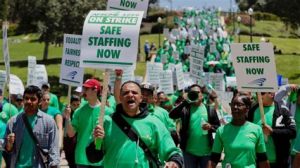Also at Counterpunch.
The strike, sick out, and slowdown are among the most effective weapons in the arsenal of class struggle. They disrupt production and interrupt the flow of profits. But the most effective weapons are also the most demanding. Strikes require discipline, sacrifice, and struggle. Strikes are short-term pain for long-term gain. It’s not a coincidence that as strikes fell out of use over the last few decades the US working class fell too.

Striking for Life: Protect the Front-line, Not the Bottom Line.
The most dramatic examples of the General Strike are the many wildcat strikes across the country. Follow the action at On The Picket Line or check out this interactive map of strike actions, or the “Dual Power” map by Black Socialists in America. Get in the loop and get connected at General Strike 2020.
If you are an essential worker and risking your life — talk to your co-workers. Form a clandestine strike committee and speak to, and listen to, everyone in the shop. A strike, sick-out, or slowdown can last a few hours, a day or indefinitely. Don’t hoodwink the workers into thinking it will be easy, but when life hangs in the balance the choice becomes clear.
Wildcats are strikes led by the rank and file workers, not union officials. This is a hidden strength. The kind of actions that were the backbone of the general strikes during the 20th century are now illegal — here in the land of the free. “Sympathy” or secondary strikes where workers strike — not out of a specific grievance with their own boss — but in solidarity with other strikers were made illegal. Russia-gate’s forerunners — the anti-communist purges of the Cold War and McCarthyism gave us the 1947 Taft-Hartley “slave labor act” that tamed the labor movement. Until this day, union officials that call sympathy strikes are treated as criminals — but the wildcats strikes have no official leaders.
In all those years since 1947 Democrats made not a single serious attempt to repeal Taft- Hartley. Maybe we can repeal it through direct action. Anyone who knows this history knows that Russia-gate and China-hate is no friend to the US working-class.
How can we help strikers?
Local efforts may be best. You can support your local strikers by setting up a “gofundme” account for them. Mask up and observe physical distance, but show up at picket lines with food and beverage. Join your local Mutual Aid team and help back up strikers.
Learn from our new leaders. Do what the strikers ask you to do. They know best.
Strategic boycotts in alignment with strikers are an important way to slow profits — the main form of leverage strikers have. Boycott Bezos for starters.

Sick Out and Slow Down
For at-home workers, the sick out and slow down are tailor-made for you. Call in sick sometime in the first week in May. Mild symptoms; a day or two, severe; a week or more. How sick are you? Only you know. Get it? Or, take a sick day, go back for one, then take another sick day. Can’t take the whole day, take half a day. Can’t take half a day just slow down — cut your production in half or more.
Almost all stuck-at-home workers I speak with are having symptoms due to isolation and confinement. Time for a mental health day? You owe yourself one.
One of the classic slowdown tactics is “Work to Rule.” Workplace rules are usually the product of the Human Relations department meant to put a liberal face on exploitation. But these rules often slow down production and are routinely ignored by management and worker alike. Study your “handbook” and find the weakness. Sometimes you can actually slow down by following the rules.
Resistance
Working people have always resisted. Unfree workers, like slaves, developed forms of resistance to oppose slave owners. We can use the same kinds of resistance to oppose corporate power.
- Pilfer. “Steal” it back to reclaim value the boss stole from you in the first place. Let the bosses pay.
- Sabotage. Break your tools. Delete paperwork. Use stealth and cunning. Don’t get caught.
- Shamming. Bullshit them. Behind your smile is the strike.
Show solidarity with the general strike. Have a strike poster in your apartment window. Wear a red or black or lavender bandana. Change your Facebook cover image.
We have to rely on the creativity and power of the people. I am confident we will figure it out. The general strike has no central committee and that is probably a good thing since no one has all the answers. Let the people decide. You can best determine the kind of action you can take.
Just remember: whatever small step you take, you are part of something bigger. And the whole is greater than the sum of its parts.
No one can do everything but everyone can do something.
